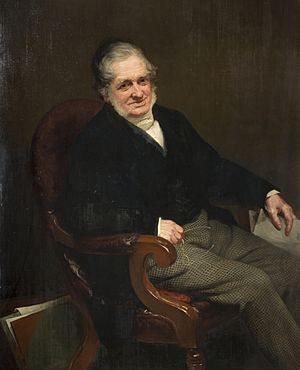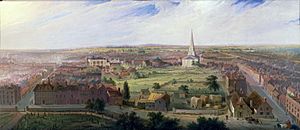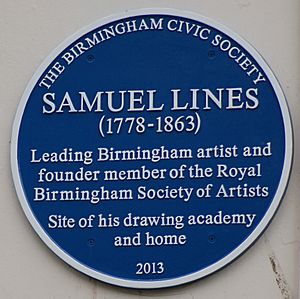Samuel Lines facts for kids
Samuel Lines (born 1778 – died November 22, 1863) was an English artist. He was a designer, a painter, and a very important art teacher. He was also one of the first members of the Birmingham School of landscape painters.
Samuel Lines played a big part in developing art in Birmingham. This was when the city was growing very fast in the early 1800s. He was a pioneer in teaching drawing and painting there. He also helped start a special art school. This school taught "life drawing," which means drawing from real models. Over time, this school grew into the famous Royal Birmingham Society of Artists and the Birmingham School of Art.
Contents
Samuel Lines' Life Story
Samuel Lines was born in a village called Allesley in Warwickshire. His mother was a school teacher there. When he was young, he worked in farming for his uncle. But in 1794, he moved to Birmingham.
Starting His Career
In Birmingham, Samuel Lines began an apprenticeship. He worked as a designer for a company called Thomas Keeling. This company made clocks and decorated things with enamel. After that, he worked for Messrs Osborn and Gunby. There, he decorated sword blades and created designs. He was very skilled at engraving too.
Samuel Lines also studied drawing. He learned from a teacher named Joseph Barber at his art school.
Opening His Own Art School
In 1807, Samuel Lines opened his own art school. It was on Newhall Street in Birmingham. He taught students how to draw and paint. His school was so successful that he was able to build his own house. It was located on Temple Row.
Many famous artists learned from Samuel Lines. Some of his students included Thomas Creswick and William Wyon. His own sons, Samuel Rostill Lines, Frederick Thomas Lines, and Henry Harris Lines, also studied with him. His art classes were known for starting very early, at five o'clock in the morning! Samuel Lines would even visit students who were late to wake them up.
Impact on Birmingham's Industries
Samuel Lines' teaching helped more than just fine artists. It also greatly improved the quality of design and craftsmanship in Birmingham's factories. In 1854, there was an exhibition of his students' work. It was found that over 42 of Birmingham's top manufacturers had learned their basic art skills at his academy. This shows how important his school was for the city's industries.
Founding Art Societies
Samuel Lines' own school held art shows every year. They gave out prizes for the "Best Perspective Drawing" and "Best Drawing in the Round." But Lines wanted something bigger. He said he wouldn't be happy until there was a public art show, like the Royal Academy in London.
In 1809, he and other local artists started the Birmingham Academy of Arts. This was a school for life drawing. It was closer to what Lines had imagined. In 1814, they held their first public art show.
In 1821, this group was restarted as the Birmingham Society of Arts. Wealthy people in the city helped make this happen. Later, in 1842, some artists left to form the Birmingham Society of Artists. This happened because they disagreed with the society becoming a government design school.
Samuel Lines was the treasurer and curator of the society for a long time. He retired when he was eighty years old. After that, he was made an honorary life member. He is buried in the graveyard of St Philip's Cathedral in Birmingham. His monument there is a protected historical site.
Even though he was best known as a teacher, Samuel Lines was also a painter. Several of his landscape paintings are in the Birmingham Museum and Art Gallery. These paintings show different places and views.
Remembering Samuel Lines
In December 2013, a special blue plaque was put up in Birmingham. It was placed on the Old Joint Stock pub. This building used to be a bank, and it stands where Samuel Lines' home and art school once were. Blue plaques are put on buildings to remember important people who lived or worked there.




